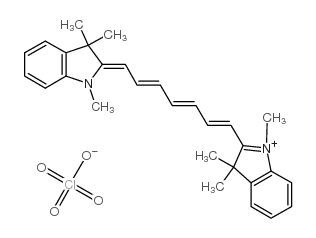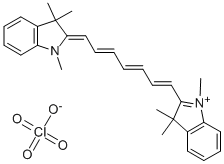1,1',3,3,3',3'-六甲基吲哚三羰花青高氯酸盐 ,1,1',3,3,3',3'-Hexamethylindotricarbocyanine perchlorate ,>98%(HPLC)
产品编号:Bellancom-B260830| CAS NO:16595-48-5| 分子式:C29H33ClN2O4| 分子量:509.04
本网站销售的所有产品仅用于工业应用或者科学研究等非医疗目的,不可用于人类或动物的临床诊断或者治疗,非药用,非食用,
| 英文名称 | 1,1',3,3,3',3'-Hexamethylindotricarbocyanine perchlorate |
|---|---|
| CAS编号 | 16595-48-5 |
| 产品熔点 | 235ºC (dec.)(lit.) |
| 精确质量 | 508.21300 |
| PSA | 80.52000 |
| LogP | 6.91080 |
| 稳定性 | 遵照规定使用和储存则不会分解。 |
| 储存条件 | 密闭于阴凉干燥环境中 |
相关文档
化学品安全说明书(MSDS)
下载MSDS质检证书(COA)
相关产品
| 危害码 (欧洲) | Xi;O |
|---|---|
| 风险声明 (欧洲) | R8;R36/37/38 |
| 安全声明 (欧洲) | S17-S26-S36 |
| 危险品运输编码 | UN 1479 |
| 包装等级 | III |
| 危险类别 | 5.1 |
Synonym:3H-Indolium Section 2 - COMPOSITION, INFORMATION ON INGREDIENTS
Risk Phrases: 8 Section 3 - HAZARDS IDENTIFICATION EMERGENCY OVERVIEW
Contact with combustible material may cause fire.Heat sensitive. Potential Health Effects Eye: May cause conjunctivitis. May cause permanent corneal opacification. Skin: May cause severe irritation and possible burns. Ingestion: May cause burns to the gastrointestinal tract. May cause nausea, vomiting, and diarrhea, possibly with blood. Inhalation: May cause acute pulmonary edema, asphyxia, chemical pneumonitis, and upper airway obstruction caused by edema. Chronic: Effects may be delayed. Section 4 - FIRST AID MEASURES Eyes: Flush eyes with plenty of water for at least 15 minutes, occasionally lifting the upper and lower eyelids. Get medical aid immediately. Skin: Get medical aid. Flush skin with plenty of water for at least 15 minutes while removing contaminated clothing and shoes. Discard contaminated clothing in a manner which limits further exposure. Ingestion: Never give anything by mouth to an unconscious person. Get medical aid immediately. Do NOT induce vomiting. If conscious and alert, rinse mouth and drink 2-4 cupfuls of milk or water. Inhalation: Get medical aid immediately. Remove from exposure and move to fresh air immediately. If not breathing, give artificial respiration. If breathing is difficult, give oxygen. Do not use mouth-to-mouth resuscitation if victim ingested or inhaled the substance; induce artificial respiration with the aid of a pocket mask equipped with a one-way valve or other proper respiratory medical device. Notes to Physician: Section 5 - FIRE FIGHTING MEASURES General Information: As in any fire, wear a self-contained breathing apparatus in pressure-demand, MSHA/NIOSH (approved or equivalent), and full protective gear. Strong oxidizer. Contact with other material may cause fire. During a fire, irritating and highly toxic gases may be generated by thermal decomposition or combustion. Use water with caution and in flooding amounts. Some oxidizers may react explosively with hydrocarbons(fuel). May accelerate burning if involved in a fire. Containers may explode when heated. Extinguishing Media: Use agent most appropriate to extinguish fire. Contact professional fire-fighters immediately. For small fires, do NOT use dry chemicals, carbon dioxide, halon or foams. USE WATER ONLY. For large fires flood fire with water from a distance. Section 6 - ACCIDENTAL RELEASE MEASURES General Information: Use proper personal protective equipment as indicated in Section 8. Spills/Leaks: Clean up spills immediately, observing precautions in the Protective Equipment section. Sweep up, then place into a suitable container for disposal. Remove all sources of ignition. Provide ventilation. Do not use combustible materials such as paper towels to clean up spill. Section 7 - HANDLING and STORAGE Handling: Wash thoroughly after handling. Remove contaminated clothing and wash before reuse. Use only in a well-ventilated area. Minimize dust generation and accumulation. Do not get in eyes, on skin, or on clothing. Keep away from heat, sparks and flame. Avoid contact with clothing and other combustible materials. Do not ingest or inhale. Storage: Keep away from heat, sparks, and flame. Do not store near combustible materials. Store in a tightly closed container. Store in a cool, dry, well-ventilated area away from incompatible substances. Section 8 - EXPOSURE CONTROLS, PERSONAL PROTECTION Engineering Controls: Facilities storing or utilizing this material should be equipped with an eyewash facility and a safety shower. Use process enclosure, local exhaust ventilation, or other engineering controls to control airborne levels. Exposure Limits CAS# 16595-48-5: Personal Protective Equipment Eyes: Wear appropriate protective eyeglasses or chemical safety goggles as described by OSHA's eye and face protection regulations in 29 CFR 1910.133 or European Standard EN166. Skin: Wear appropriate gloves to prevent skin exposure. Clothing: Wear appropriate clothing to prevent skin exposure. Respirators: A respiratory protection program that meets OSHA's 29 CFR 1910.134 and ANSI Z88.2 requirements or European Standard EN 149 must be followed whenever workplace conditions warrant respirator use. Section 9 - PHYSICAL AND CHEMICAL PROPERTIES Physical State: Powder Color: green Odor: none reported pH: Not available. Vapor Pressure: Not available. Viscosity: Not available. Boiling Point: Not available. Freezing/Melting Point: 235 deg C(dec) Autoignition Temperature: Not applicable. Flash Point: Not applicable. Explosion Limits, lower: Not available. Explosion Limits, upper: Not available. Decomposition Temperature: 235 deg C Solubility in water: Not available. Specific Gravity/Density: Not available. Molecular Formula: C29H33ClN2O4 Molecular Weight: 509.03 Section 10 - STABILITY AND REACTIVITY Chemical Stability: Stable under normal temperatures and pressures. Unstable if heated. Conditions to Avoid: Incompatible materials, ignition sources, dust generation, combustible materials, reducing agents, strong oxidants, heat. Incompatibilities with Other Materials: Reducing agents, heat, strong reducing agents, organic matter, finely powdered metals. Hazardous Decomposition Products: Hydrogen chloride, nitrogen oxides, carbon monoxide, irritating and toxic fumes and gases, carbon dioxide. Hazardous Polymerization: Has not been reported Section 11 - TOXICOLOGICAL INFORMATION RTECS#: CAS# 16595-48-5 unlisted. LD50/LC50: Not available. Carcinogenicity: 3H-Indolium,2-7-(1,3-dihydro-1,3,3-trimethyl-2H-indol-2-ylie - Not listed by ACGIH, IARC, or NTP. Section 12 - ECOLOGICAL INFORMATION Section 13 - DISPOSAL CONSIDERATIONS Dispose of in a manner consistent with federal, state, and local regulations. Section 14 - TRANSPORT INFORMATION IATA Shipping Name: OXIDIZING SOLID, N.O.S.* Hazard Class: 5.1 UN Number: 1479 Packing Group: III IMO Shipping Name: OXIDIZING SOLID, N.O.S. Hazard Class: 5.1 UN Number: 1479 Packing Group: III RID/ADR Shipping Name: OXIDIZING SOLID, N.O.S. Hazard Class: 5.1 UN Number: 1479 Packing group: III Section 15 - REGULATORY INFORMATION European/International Regulations European Labeling in Accordance with EC Directives Hazard Symbols: O Risk Phrases: R 8 Contact with combustible material may cause fire. Safety Phrases: S 17 Keep away from combustible material. WGK (Water Danger/Protection) CAS# 16595-48-5: No information available. Canada CAS# 16595-48-5 is listed on Canada's NDSL List. CAS# 16595-48-5 is not listed on Canada's Ingredient Disclosure List. US FEDERAL TSCA CAS# 16595-48-5 is listed on the TSCA inventory. SECTION 16 - ADDITIONAL INFORMATION N/A |








 浙公网安备 33010802013016号
浙公网安备 33010802013016号